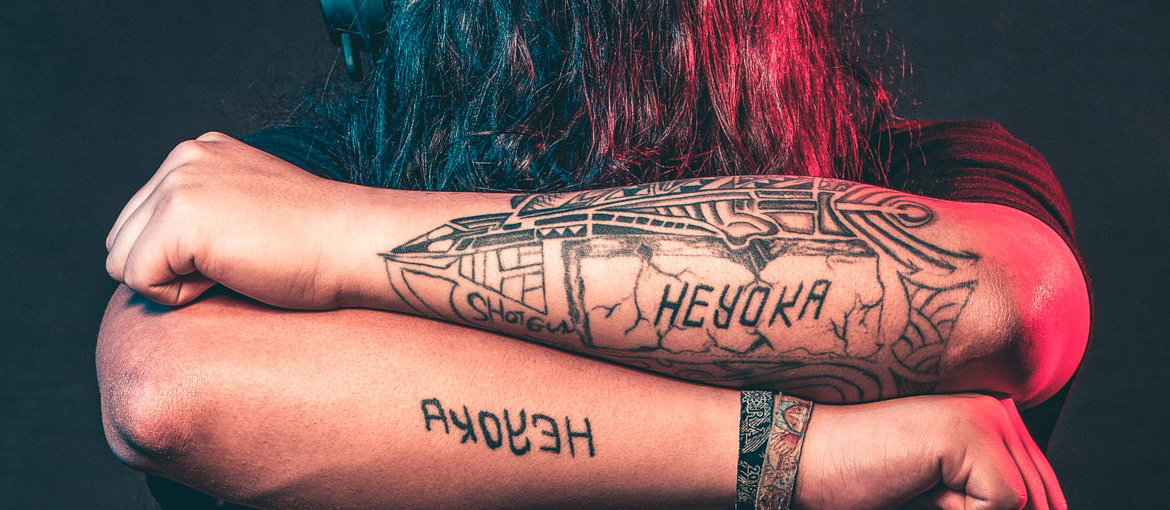He is only 26 years old, but he has already been a tattoo artist for nine years. Teenager Emerson Ventura only needed to walk into a tattoo studio once in his native Brazil to know immediately that this was his path, his real modus vivendi. And from then on, with a graffiti artist background behind him, he began drawing compulsively until he was 17, when he tattooed the word “vegan” on a friend who had lent himself as a guinea pig. “My hands were shaking,” he recalls.

Currently, Emerson works at the prestigious Barcelona-based Family Art Tattoo, studio, where he creates spectacular tattoos in a style with Tibetan influences. Choosing to get tattooed is by no means a trivial act: to those who choose them, the symbols, designs and letters on the skin will forever remind them of a person, a family member, a friend, but also of a powerful moment experienced in their lives.
As for letters, it is not only important to think about the word or message itself, but also to think about the care of typographic aesthetics. Oriental, Gothic, Arabic, calligraphic fonts, geometric shapes, ornaments, and even Roman numerals: the fact remains that shape, thickness, size, and color are all relevant aspects to weigh when deciding to get tattooed because they can turn your skin into a true work of art.

Needless to say, the Internet can be an inexhaustible source of typographic inspiration for a tattoo. Just take a look at pages like Dafont or Conversordeletras, where the user will be spoiled for choice among thousands of fonts classified by style. Once the style is selected, one can type in the word or phrase to be tattooed and select the size to get a concrete idea of the result. These pages are free, but for those who want to contribute to the hard work of the designers instead, there are also options such as MyFont from which to download fonts starting at modest prices, and again 1001 Free Fonts, where you can make a donation. The third solution is to hire an experienced tattoo lettering designer-although really any handwriting and calligraphy is fine as long as it meets basic aesthetic standards.

Showing up at a tattoo studio with an already identified typographic style is the first step, but there is no doubt that the tattoo artist’s experience is what can best advise us going into the second step. “I always propose my own lettering because I love calligraphy. However, there are clients who come with a specific font in mind. They ask me for typewriter fonts or to recreate a family member’s handwriting – then I always make sure to follow a certain aesthetic consistency,” Emerson explains. His handwriting is a classic cursive style; he confirms that it is also the most requested style of the moment. Regardless of the choice you make, Emerson always recommends sticking to a minimum size, because over time you run the risk of the tattoo ending up as just a dark stain. And beware: spelling mistakes that would scar the body forever are not allowed.

Once the typography and the area of the body to be tattooed have been agreed upon, it’s time to print out the design, run it through the computer for a touch-up, and then proceed to trace it back onto the skin with ink and pigments. Despite the advances in technology – tattooing tools are much more precise and the materials available of great quality – drawing by hand on a “canvas” (and in this case, on the largest organ of the human body, the skin) “may look easy but it is not. Drawing even one line to perfection requires great mastery of technique.” Handling a vibrating instrument, calculating spaces to the millimeter, being deft and precise so as not to smudge the dye are then all indispensable skills. “The things to handle at the same time are many. It’s like learning to drive a car: it’s stressful at first, but after a while it becomes an almost mechanical act,” explains the Brazilian tattoo artist.
Mechanical or not, one thing is certain: looking at the result, we cannot help but marvel and admire the skill of the tattoo artists who shape words and messages destined to last an eternity, like great little works of art on the skin.


